Bulletin – June 2019 Global Economy China's Local Government Bond Market
- Download 442KB

Abstract
China's local government bond market is a key source of financing for local governments, particularly to fund infrastructure investment. The market has grown rapidly in recent years but is still relatively illiquid and has a narrow investor base. It also shows little difference in pricing of credit risk across different bond types and issuers, partly due to the perception that local governments enjoy an implicit guarantee from the central authorities. The Chinese Government has implemented measures to foster the development of these features of the market, bearing in mind risks to financial stability.
Introduction
China's local government bond market has grown rapidly in recent years and is now the largest municipal bond market in the world (Graph 1).[1] It is now also the largest bond market in China (Graph 2). The market is an important source of financing for local governments in China, which are responsible for a large share of total government expenditure (around 85 per cent) and which undertake the bulk of public infrastructure investment (Wilkins and Zurawski 2014). Bonds made up around 90 per cent of local government debt in 2017, compared with 7 per cent in 2014 when debt mainly comprised of off balance sheet borrowing from banks (Lam and Wang 2018).

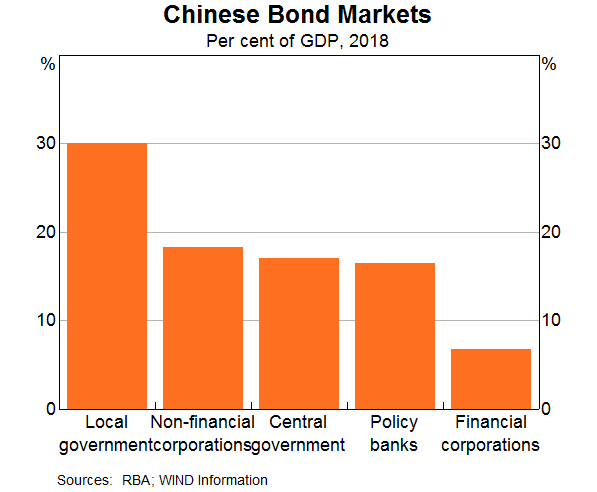
This article discusses the growth in the size and importance of the local government bond market in China. It describes the emergence of the market, which has been heavily influenced by regulatory changes and other policies of the central government. It then examines the market's investor base, liquidity and pricing, and discusses recent reforms that aim to further develop the market.
The Emergence of the Market
Before 2015, the size of the local government bond market was limited by China's Budget Law 1994, which prohibited borrowing by most local governments. As a result, local governments raised funds by forming off-balance sheet entities known as local government financing vehicles (LGFVs). These LGFVs sourced credit, in large part, from outside the regular banking system. Such funding is known as ‘shadow financing’ and is subject to limited prudential oversight. Local government borrowing through LGFVs increased sharply from 2009, when China's central government announced a stimulus package to support economic growth, which included approximately CNY3 trillion of infrastructure investment that was mostly undertaken by local governments (McKissack and Xu 2011).
In 2014, to increase the transparency of local government borrowing and reduce financial stability risks, China's central government adopted a strategy of ‘opening the front door and closing the back door’ for local government borrowing. The authorities revised the Budget Law to allow local governments to raise debt directly from bond markets, while increasing regulatory scrutiny of borrowing by LGFVs. The authorities also introduced a three year ‘debt swap’ program in 2015, under which local governments were able to convert the debt of LGFVs (including bank debt, debt owed to non-bank entities, and LGFV bonds) into local government bonds. Around CNY15 trillion of debt-swap bonds were issued under the program, and these bonds currently comprise around half of the outstanding stock of local government bonds. As well as increasing transparency, the debt-swap program enabled local governments to extend the average maturity of debt and reduce interest costs (Lam and Wang 2018).
The market has also grown as the authorities have approved significant increases in issuance in recent years. Issuance of local government bonds is subject to strict quotas, which are approved by the National People's Congress (NPC), China's national legislature, when it meets in March each year.[2] Quotas are set based on the funding needs of local governments, their capacity to service their debts and the economic priorities of the central government. Recently, a key priority has been to increase infrastructure investment by local governments, which had slowed over the past year or so. Accordingly, most issuance recently has been of ‘special bonds’, which are issued to finance specific infrastructure investments, and most of which have their repayments tied explicitly to project revenues, rather than repaid from general local government revenue. A smaller share of issuance has been of ‘general bonds’, which finance broader government spending.
At the NPC's most recent meeting, the Chinese authorities significantly increased the quota for local government bond issuance in 2019. The authorities set the quota at CNY3.1 trillion (3 per cent of GDP), almost one-third larger than for 2018 (Graph 3). This reflected a sharp increase in the quota for special bonds and a small increase in the quota for general bonds. The authorities have instructed local governments to complete their issuance of special bonds this year by September, to encourage local governments to bring forward their infrastructure investment (Xinhua 2019).
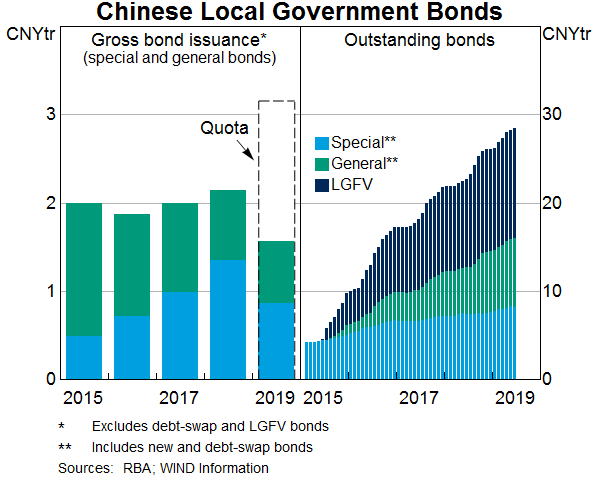
Features of the Market
Despite the recent rapid growth in issuance, the local government bond market in China is still developing in some key respects.
Narrow investor base
The Chinese local government bond market has a narrow investor base, with Chinese commercial banks holding almost 80 per cent of outstanding bonds (Graph 4). These holdings account for around 7 per cent of total commercial banking assets in China. China's national commercial banks, which make up over half of China's banking system, are the primary purchasers of local government bonds (Graph 5). In contrast, a diverse range of institutional and non-institutional investors hold municipal bonds in the United States and Japan, and municipal bonds make up only around 2 per cent of total banking assets in the United States. The narrow investor base of Chinese local government bonds in large part reflects the authorities' local government debt-swap program. Banks had been a key provider of credit to LGFVs, and were the primary purchasers of bonds issued in exchange for LGFV debt.
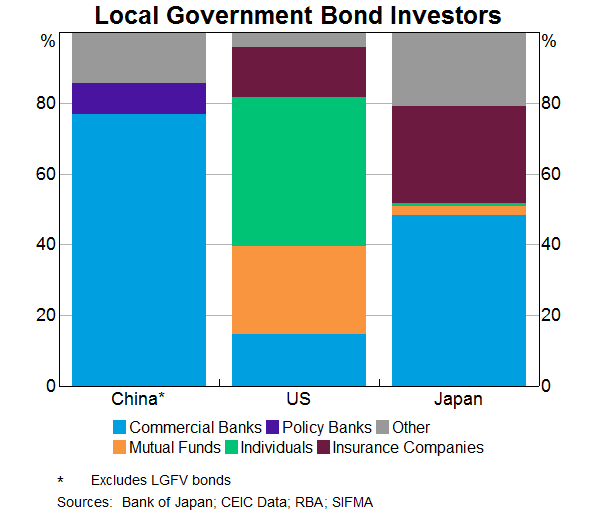
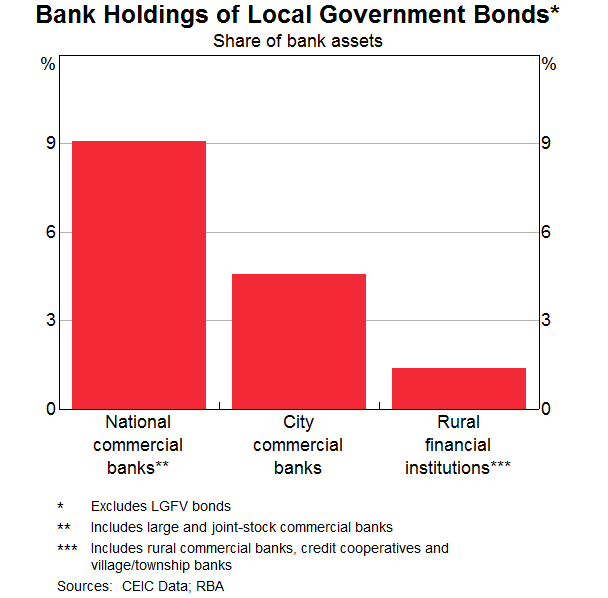
This year, China's Ministry of Finance launched a pilot program that allows retail investors to purchase local government bonds from commercial banks in order to expand the investor base. The pilot program includes bonds issued by local governments in four provinces (Shaanxi, Shandong, Sichuan and Zhejiang) and two cities (Beijing and Ningbo), which together accounted for 20 per cent of total local government bond issuance in 2018. Project-based special bonds have been selected as the first to be sold to retail investors, in part because they are explicitly linked to local infrastructure projects that residents can recognise and therefore may be more willing to purchase. In addition, any reduction in implicit guarantees on other investment products, especially wealth management products – a preferred investment product for retail investors – could make local government bonds a relatively attractive investment option in the coming years.[3]
Low liquidity
Local government bonds also tend to be relatively illiquid. In 2018, the value of secondary market transactions involving local government bonds was equivalent to only 29 per cent of the value of the outstanding stock of local government bonds. This compares with around 75 per cent for US municipal bonds and 50 per cent for Japanese municipal bonds (Graph 6). Bid-ask spreads, another indicator of market liquidity, also tend to be much wider for Chinese local government bonds relative to municipal bond markets in the United States and Japan. That being said, turnover in China's local government bond market has risen recently, perhaps reflecting policy changes intended to support market liquidity (discussed further below; Graph 7).
The narrow investor base of local government bonds may explain the illiquid nature of the secondary market. China's commercial banks tend to buy local government bonds with the intention of holding the securities to maturity. In part, this reflects the perceived low risk of default by local governments, as well as the low risk weights assigned to local government bonds under China's capital regulations. It may also reflect changes in 2015 that added local government bonds to the list of eligible collateral for various People's Bank of China lending facilities.
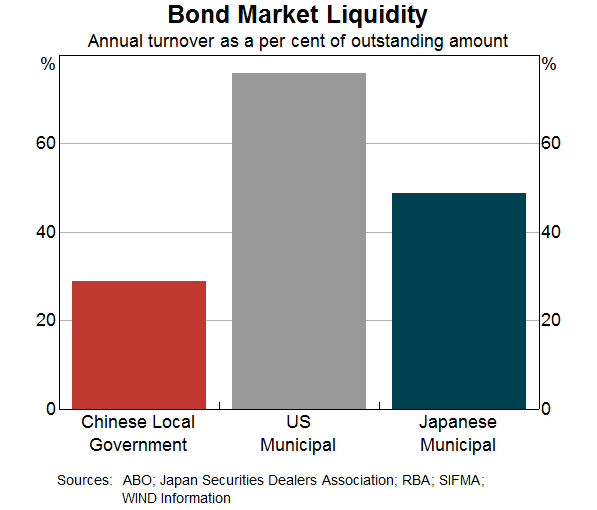
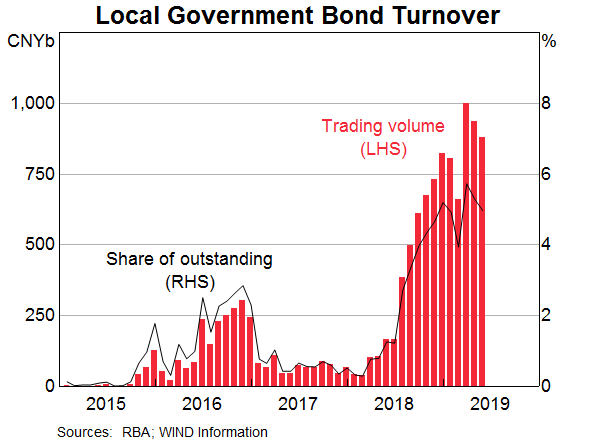
Lack of pricing discrimination
There has tended to be little difference in market pricing of credit risk, both across types of bonds (special and general bonds) and across issuers. Spreads of local government bonds to Chinese government bonds (CGBs) have been similar across Chinese local governments, despite significant variation in risk profiles and debt burdens (Graph 8). Available data indicate that almost all local government bonds are rated AAA – the highest rating – by domestic ratings agencies. There has also tended to be little difference in the market pricing of general and project-based special bonds. In part, this reflects that, while repayments of project-based bonds are linked explicitly to project revenues, final legal recourse still lies with the issuing local government (though this is untested), unlike revenue bonds in the United States and other countries.
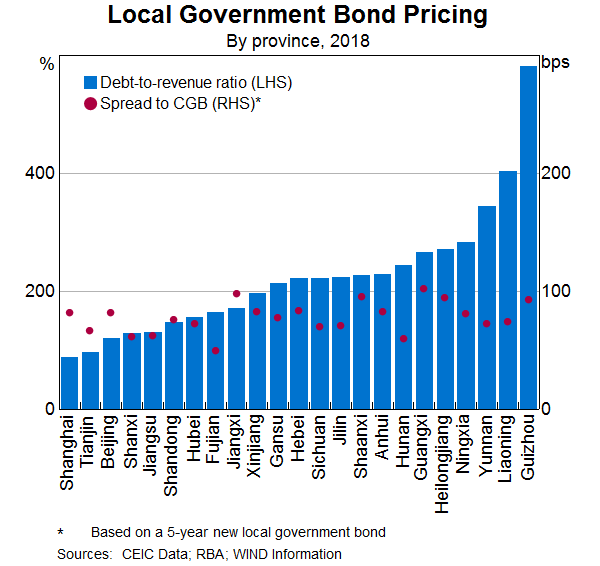
The lack of discrimination in pricing for different levels of credit risk probably reflects the widely held expectation that the central government would intervene to prevent local governments from missing bond payments. This perception has been reinforced by China's fiscal structure, under which many local governments have limited control over revenue raising and, therefore, rely to a large extent on central government transfers to help finance their activities. In addition, the central government, through the Ministry of Finance, approves the amount and minimum pricing of local government bond issuances, which can reinforce the perception of support by the central authorities. These implicit guarantees could lead local governments to borrow more than market-based pricing would encourage. This moral hazard might have increased medium-term financial stability risks, to the extent that bond proceeds have been used to finance projects with low marginal returns (Schipke, Rodlauer and Zhang 2019).
Regulatory changes to remove perceptions of implicit local government guarantees for off-balance sheet debt have contributed to some repricing of credit risk in the local government bond market. The efforts contributed to a considerable widening in spreads on low-rated LGFV bonds in 2018 to a level comparable with those of corporate bonds with similar ratings (Graph 9). However, spreads have narrowed more recently following the relaxation of rules at China's largest securities exchanges that allow some refinancing of LGFV debt to ease financing pressures for local governments.[4]
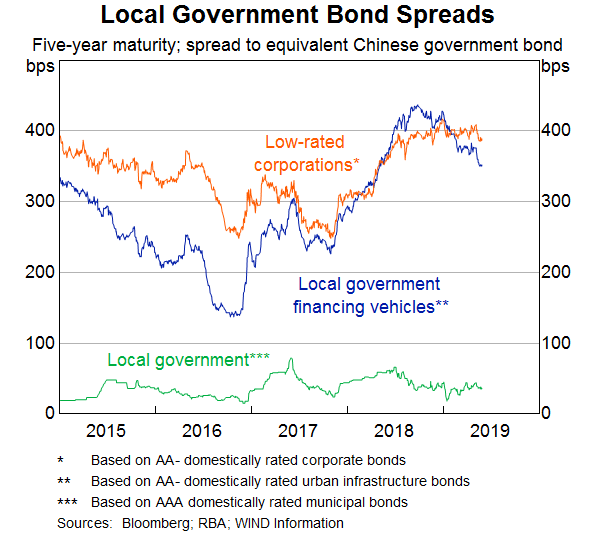
Recent Reforms to Develop the Market
In recent years, the Chinese authorities have sought to enhance the functioning of the local government bond market. Their efforts to date have sought to meet two key, and at times competing, objectives: supporting local government finances, including by ensuring that the market can digest increasing issuance; and fostering the development of a liquid market with a diverse investor base in which pricing incorporates credit risk. In response, the authorities have had to prioritise and carefully sequence reforms.
To support local government bond financing, the authorities have encouraged purchases of bonds by banks and reduced the cost of issuance by local governments. They have removed the 20 per cent limit on the share of a local government bond issuance that an underwriting bank may purchase (Hongyuran, Kan and Cheng 2018). The authorities have also reduced the minimum spread to CGBs at which local governments can issue bonds, from 40 to 25 basis points (Yuzhe, Qingin and Jia 2019).[5] In addition, the authorities have announced that local governments may use the proceeds of special bond issuance to satisfy minimum equity requirements for certain projects (Xinhua 2019).
The authorities have also implemented measures to improve the pricing of credit risk. They have prohibited local governments from guaranteeing LGFV debt and required disclosure of more information to investors and the central government, including about the financial position of issuers and the projects that bond proceeds will fund (Ministry of Finance 2018a). In addition, the Ministry of Finance has encouraged the issuance of project based special bonds, which have their repayments linked explicitly to project revenues, rather than being repaid from local government revenues (though, as noted, final legal recourse remains with the issuing local government). This includes significantly expanding the range of investments that project-based special bonds may fund.[6]
Finally, the authorities have sought to diversify the investor base for local government bonds. They have permitted issuance at longer maturities of up to 20 years to encourage participation by long-term institutional investors, such as mutual funds and life insurance companies (Ministry of Finance 2018b). The authorities have also introduced channels for non-financial corporations and retail investors to purchase a limited selection of local government bonds through China's banks (Ministry of Finance 2019).
While seeking to enhance market functioning in these various ways, the authorities also have been conscious of the need to minimise the risk of significant market disruptions. Given their significant holdings of local government bonds, China's commercial banks could be adversely affected by abrupt changes in policy (however unlikely) that allow defaults by local governments. Also, if a reassessment of implicit guarantees reduces local government bond prices, banks may need to revalue the securities held on their books. This could put pressure on their profitability and balance sheets. An upward repricing of risk could also increase the cost of financing infrastructure investment for local governments, particularly those with relatively large debt burdens. This might undermine efforts to increase infrastructure spending by local governments.
Conclusion
China's local government bond market has grown rapidly in recent years and is now the largest municipal bond market in the world. Its size and importance is likely to grow further, in line with the authorities' goals of increasing infrastructure investment by local governments and improving the transparency of local government borrowing. However, the local government bond market in China is relatively illiquid and the investor base narrow, and there has been little difference in market pricing of credit risk, reflecting the prevalence of implicit guarantees. Efforts to reduce the perception of government guarantees might help to reduce moral hazard, but could also increase the funding costs of local governments. This is likely to remain a challenge for policymakers as they seek to foster the ongoing development of the local government bond market.
Footnotes
Alex Holmes completed this work in International Department, and David Lancaster is from International Department. The authors would like to thank Adam Cagliarini, Christian Vallence, Christopher Kent, Ivan Roberts and Mark Hack for their comments and suggestions. [*]
In China, local governments comprise a wide range of sub-national bodies at provincial, prefectural, county and township levels. [1]
Historically, local governments have used their full quota for bond issuance. Between 2019 and 2022, China's State Council will have scope to approve an initial quota of up to 60 per cent of the previous year's quota before the final quota is approved by the NPC in March, allowing local governments to issue bonds in the first quarter of the year (Xinhua 2018). [2]
By 2021, changes to asset management regulations will remove implicit guarantees by financial institutions on all outstanding wealth management products. For more information about wealth management products, please see Perry and Weltewitz (2015). [3]
The Shanghai and Shenzhen Stock Exchanges relaxed rules that had prevented LGFVs issuing refinancing bonds (with terms less than 6 months) if the issuer sourced more than 50 per cent of their overall revenue from local governments. [4]
The Ministry of Finance regulates the spread that local government bonds can be issued over the five-day average yield of central government bonds of the same maturity. [5]
While initially created to fund social housing and transport infrastructure, project-based special bonds may now finance over 20 types of projects, including in the education, water and real estate sectors. [6]
References
Bowman J, M Hack and M Waring (2018), ‘Non-bank Financing in China’, RBA Bulletin, March, viewed 23 May 2019.
Chen Z, Z He, and C Liu. (2018), ‘The Financing of Local Government in the People's Republic of China: Stimulus loan wanes and shadow banking waxes’, National Bureau of Economic Research Working Paper 23598.
Lam W and J Wang (2018), ‘China's Local Government Bond Market’, International Monetary Fund Working Paper No. 18/219.
Hongyuran W, H Kan and L Cheng (2018), ‘China Scraps Limits on Banks' Local Government Bond Purchases’, Caixin Online, viewed September 12. Available at <https://www.caixinglobal.com/2018-09-05/china-scraps-limit-on-banks-local-government-bond-purchases-101322947.html>.
Long C (2018), ‘A New Tool for Infrastructure Funding’, Gavekal Dragonomics, 14 September.
McKissack A and J Xu (2011), ‘Chinese Macroeconomic Management through the Crisis and Beyond’, Australian Treasury Working Paper 2011–01.
Min D and C Cheung (2018), ‘Unprecedented Inflows into the Chinese Bond Market’, Morgan Stanley, 5 December.
Ministry of Finance (2019), ‘Notice of the Ministry of Finance on Launching the Work of Issuing Local Government Bonds through the Commercial Bank Counter Market’ [in Chinese], 15 March.
Ministry of Finance (2018a), ‘Notice on Printing and Distributing the Measures for the Disclosure of Local Government Debt Information (Trial)’ [in Chinese], 29 December.
Ministry of Finance (2018b), ‘Opinions of the Ministry of Finance on Doing a Good Job in the Issuance of Local Government Bonds in 2018’ [in Chinese], May 4.
Perry E and F Weltewitz (2015), ‘Wealth Management Products in China’, RBA Bulletin, June, pp 59–67.
RBA (2018), ‘Box A: Evolving Financial Conditions in China’, Statement on Monetary Policy, November, pp 21–23.
Schipke A, M Rodlauer, and L Zhang, (eds) (2019), The Future of China's Bond Market, International Monetary Fund, Washington, DC.
Wilkins K and A Zurawski (2014), ‘Infrastructure Investment in China’, RBA Bulletin, June, pp 27–35.
Wu X (2015), ‘An Introduction to Chinese Local Government Debt’, MIT Center for Finance and Policy Working Paper.
Xinhua (2018), ‘China to Speed Up Local Government Bond Issuance’, 29 December.
Xinhua (2019), ‘China steps up local gov't bond issuance to support key areas, major projects’, 10 June.
Yuzhe Z, P Qingin and D Jia (2019), ‘China Cuts Local Government Bond-Rate Guidance’, Caixin Online, viewed February 1. Available at <https://www.caixinglobal.com/2019-01-30/china-cuts-local-government-bond-rate-guidance-101375892.html>.